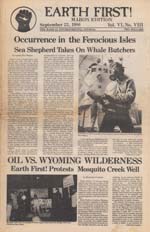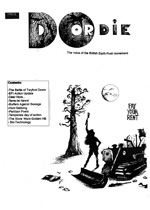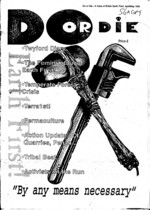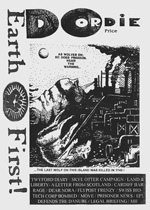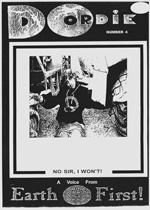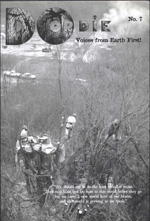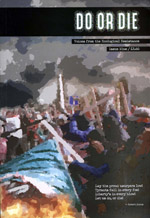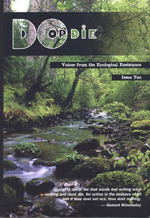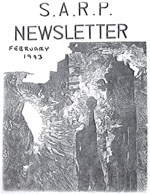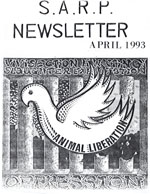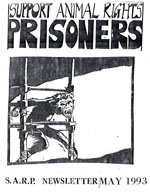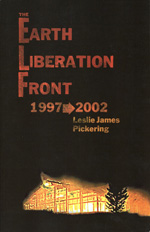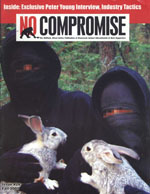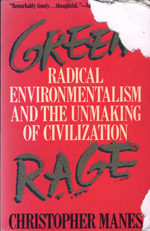The Archives
-
Earth First! Journal, Periodicals
Earth First! Journal 1987
11.03.14 | PermalinkEarth First! Journal (1987, Issue #1-8. Tucson, AZ.)
Writing about Earth First! during its 1980s heyday is a delicate matter. I want to celebrate their best tendencies without ignoring their worst. 1987 is a particularly difficult year to do the former.
After the publication of an article called “Alien Nation” called for a closing of the US border to immigrants (strictly for environmental reasons we are told, not because EF! icon Ed Abbey advocated the use of the term “wetback” and used “cultural chauvinist” to describe his particular brand of racism) anarchists challenged the authors at a gathering in late 1986. So began a years worth of letters to the editor defending the piece. More than one missive in this volume praised AIDS as a positive development for the environment, and various racist, classist, and macho arguments bleed into many of the pages. Given these facts it feels callous to point to the positives that this volume also contains, so I will leave it to our readers to discover those for themselves.
Earth First! is a complex non-organization that has gone through many incarnations, changes in direction, and has never had a political consensus on any issue during the entirety of its history. If I can point out one mitigating factor for these eight issues it is that at least some Earth First!ers fought back in print and in person against the most backwards opinions of their peers, something still needed in the movement today.
…
-
Do or Die, Most Popular, Periodicals
Do or Die – The Complete Set!
04.09.14 | PermalinkDo Or Die #1-10 (1993-2003, Brighton, England.)
A few years ago a friend asked me if I had a complete set of Do or Die, the British Earth First! publication that inspired and incited eco-warriors throughout the 1990s and early 2000s. At one time I did have them, but they had long since been stolen by a Joint Terrorism Task Force.
After a brief discussion, we decided that Do or Die was too important to fade into obscurity. We began tracking down each issue, and decided that while we were at it we ought to archive some other publications as well. That effort is how this web site began, and now, thanks to 56a infoshop of South London and Tim @ NEDS Northampton, we can finally share the very rare issue #2. This completes our collection, and our original mission as well.
When read as a set, Do or Die is a chronicle of people from across the globe counter-striking capitalism, ecocide, and the state. Each issue is better than the last, but more importantly, each page is a spark licking at the fuse of the bomb that is your heart. Once lit, you’ll know that these pages are not mere history, but a reminder that we can explode onto the world stage like the fighters before us have. Do or die, now is the time to rise.
…
-
Periodicals
S.A.R.P. newsletters year 3
10.25.13 | PermalinkS.A.R.P. Newsletter #12-15 (1993 – Northampton, England)
Only a few short years after reforming Support Animal Rights Prisoners, the contributors to the project (primarily Barry Horne) threw in the towel. Their raison d’être was being fulfilled by the ALF SG newsletters, and Barry felt as if the group wasn’t having the unifying, inspirational impact that he had hoped for. The final issue, mostly written by press officer Robin Webb, starts off light and positive, but ends with an angry missive from Horne accusing most activists of being mere radical t-shirt collectors rather than actual radicals. Across the span of decades and beyond even his own death, this stab at those unwilling to fight for liberation still hits its mark. It is a sad ending to an information packed publication, but not every issue of this last year of SARP is so intense. Tiny fragments of our history fall off these pages like gold dust- collect them together and you have a treasure. Barry might have died on hunger strike, but he did not leave us behind. His words and actions will continue to remind us where we came from, and for whom we fight. Rest in peace, comrade, and thank you for all you have given us…
…
-
Do or Die, Most Popular, Periodicals
Do or Die #10
06.10.13 | PermalinkDo Or Die #10 (2003, Brighton, England.)
It’s hard to believe that it has been a decade since the Do or Die collective published the final issue of their influential, book sized periodical. This last dispatch screamed the same urgent message as its predecessors: Take action now, or die alongside the rest of humanity in the coming ecological meltdown.
In the ten years since our situation has only become more desperate, and therefore the inciting cries for resistance in the pages of Do or Die have only increased in relevance. Plenty has been written on this site about this publication: that it was our reason for starting TALON, that it was the best environmental publication ever, and so on. None of that will matter if DoD’s message is ignored. Read these pages with an eye towards how you will utilize the lessons contained inside. Then, start making plans to create a better world, and implement those plans quickly, because as the title suggests, if you don’t “Do” than our species has only one other option…
The other issues of Do or Die in our archive can be found HERE.
…
-
Books
Earth Liberation Front 97-02
05.20.13 | PermalinkEarth Liberation Front 1997-2002 (2003. Second printing with new dedication and layout 2007. Portland, OR)
Leslie James Pickering grew up in Buffalo, NY. In the mid 90s he became involved in the local hardcore music scene. While attending shows in the surrounding area, he began reading the literature distributed there by local animal rights groups. Zines such as Holocaust (published by Animal Defense League founder Kris Qua) were his introduction to radical politics and support for underground direct action.
Like most kids who grow up in smaller cities, Leslie James left Buffalo as soon as he had the means. After a brief stint skateboarding in San Francisco (during which time he filmed for the underground skate video rarity “Heat Zone”) Pickering landed in Portland, OR. There, he met Craig Rosebraugh, and after a few years the two of them began publishing a newspaper called Resistance with other members of a group called Liberation Collective. At this same time, a group calling themselves the Earth Liberation Front began a series of arson attacks against companies involved in logging and other environmentally harmful practices. They sent their first media statement to Liberation Collective, and the rest of the story is what Pickering documents in Earth Liberation Front 97-02.
Consisting of reprints, interviews, and some original material, Earth Liberation Front 97-02 is a must read for those who wish to understand the beginnings of the Green Scare.
…
-
Most Popular, No Compromise, Periodicals
No Compromise: The Final Two Issues
05.13.13 | PermalinkNo Compromise #29-30 (2006. Santa Cruz / San Francisco, CA)
The early days of my activism were so exciting. After a lifetime of feeling powerless I suddenly discovered that there was a community dedicated to fighting the good fight. Its members were in every major city and many smaller ones, and sometimes not living in any city at all, but in trees and encampments. The people involved were empowered to act for themselves in order to create a better world, and had abandoned all the false hope of political parties and their dead politics. Words meant little, action was what counted, and the sky was the limit. The internet was not yet in wide use, and thank goodness! That meant that we met each other in conference rooms, in squats, on the streets, and sometimes on the pages of No Compromise magazine.
No Compromise shaped who I am today. Each new issue contained articles that helped me and thousands of others to evolve our own style of resistance, and as our experience grew we were able to share our stories in the pages of the magazine.
After 30 issues, the steering committee of No Compromise decided to stop publishing in 2006. Their decision could not have come at a worse time. With the SHAC website and newsletter killed by the convictions of the SHAC 7, Bite Back being published only sporadically and with a limited focus, and the Earth First! Journal mired in its “Confronting Oppression Within” drama, the sudden absence of No Compromise meant that the primary sources for radical animal liberation news, opinion, and strategy were the twin sewers of online social networks and the North American Animal Liberation Press Office. These were dark times for our movement, and we are only just beginning to recover.
The final issues of No Compromise were the best of the series, though! I was in prison when issue 30 was released, and it felt electric in my hands. I read it over and over, alternately laughing and crying. As I was putting this post together I decided to pull out that print copy. It gave me the same sense of awe I had when I read those first issues. More than that, it reminded me that there is still a community of people capable of changing the world through compassionate direct action and mutual aid. And you know what? We are going to win!
KEEP FIGHTING,
Josh Harper(The complete set of all past issues of No Compromise can be found HERE)
…
-
No Compromise, Periodicals
No Compromise #27-28
03.18.13 | PermalinkNo Compromise #27-28 (2005. Santa Cruz / San Francisco, CA)
The volunteer staff of No Compromise may have only published two issues in 2005, but both were valuable sources of news and ideas from across the globe. As always, the reports inside are bitter sweet. Many animals were rescued, many abusers felt some heat, and many people rose up and fought back. Then, there was the backlash, the senate hearings, and the arrests. The movement has never stopped though, and No Comp always served as a reminder that come hell or high water we were all going to forge ahead, sometimes stronger, sometimes weaker.
One unfortunate development in 2005 was the arrest and conviction of Chris “Dirt” McIntosh. Despite receiving movement support, Chris turned to Nazi groups in prison for advice and friendship. Soon, he counted himself among their ranks, and requested to be removed from animal lib prisoner lists. He would have been removed anyway though: there is never room in our struggle for a Nazi!
Luckily, other prisoners continued to show courage, dignity, and resolve from behind bars. Both 2005 issues of NC contain inspiring letters and interviews with jailed comrades. All in all, this is another must read year for the best animal liberation publication to come out of the United States.
…
-
Books, Most Popular
Green Rage
12.03.12 | PermalinkGreen Rage: Radical environmentalism and the unmaking of civilization (1990, Boston, MA.)
One of the first books I bought about radical wilderness defense was Green Rage. It is an excellent investigation of the origins of (western) environmental radicalism, and I recommend that you read it cover to cover.
Speaking of covers, you might notice that this particular copy of Green Rage is a little ragged. The reason for that is because this is my copy, and after reading the book I took it’s message to heart. Several years ago in Oregon, a small group of activists from around the region were protesting at a breeding facility that supplied rabbits to the vivisection industry. When we arrived the farms owners were not present, and neither were any law enforcement. Not coincidentally I quickly found myself living with some critters who liked to chew on everything in our humble home. I hope you will enjoy Green Rage as much as they did!
…
-
No Compromise, Periodicals
No Compromise #20-22
11.15.12 | PermalinkNo Compromise #20-22 (2003. Santa Cruz / San Francisco, CA)
No Comp scored another great year in 2003, this time by going deeper into practical instructions for campaigning, and also by examining the smaller stories in greater detail. While the high profile victories of anti-HLS activists were given their due, inspirational figures who had passed on were also given touching coverage. Issue #20 features articles on early Band of Mercy and Animal Liberation Front founder Sue Smith, and Sweden’s animal lib die-hard, Ake Soderlund. Similar examinations of our past, and the courageous figures whose shoulders we stand upon, pepper the 2003 issues. Of particular note is the article on Henry Hutto in issue #21.
2003 was also the year that Rod Coronado finally got off of probation and was allowed to participate in the movement again. His writings for No Compromise were as subversive and inspiring as ever, and it is easy to see why the government considered him such a threat.
As the year progressed No Comp moved to a magazine format and tightened their graphic design skills in response to Jake Conroy’s work on the SHAC USA newsletter. These glossy issues were excellent contributions to the movement, and it is a shame that in only a few more years NC would cease to exist altogether. These information (and inspiration!) packed issues are worth reading again to inform and encourage our current actions.


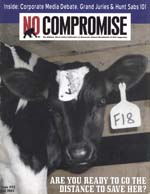
-
Earth First! Journal, Most Popular, Periodicals
Earth First! Journal 1986
09.13.12 | PermalinkEarth First! Journal Volume 7, Issue #1-8 (Tucson, AZ.)
One of our dreams here at Conflict Gypsy has been to build a complete collection of the Earth First! Journal, the radical environmental movement’s longest running periodical. While we are still missing some key issues, we have managed to gather enough of this classic publication to begin posting them one year at a time, starting with 1986.
The eight newspaper-format volumes printed by the Journal collective in 1986 are filled with fascinating tales of our eco-warrior progenitors, including Paul Watson’s epic telling of The Raid on Reykjavic in issue two. It is tempting to spend several paragraphs discussing the contents of these yellowing tomes, but perhaps it is more important to spend these words discussing the fact that the journal is still being produced- AND IT NEEDS OUR SUPPORT!
The Earth First! Journal has been documenting environmentally motivated direct action for more than 30 years, but it struggles to pay the bills these days as fewer and fewer people read print magazines. Here at CG we believe wholeheartedly that history should be “told from below,” that the words of our comrades are more important to our understanding of past events than the musings of academics and professional historians. The Journal is still the best source for this kind of news- the written accounts of actual participants in our struggle! Please do not let it disappear like so many other publications in the last decade. Subscribe to the Earth First! Journal by clicking here!







